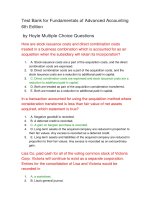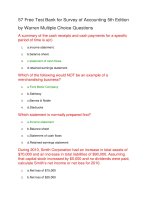Advanced accounting, 5th edition international student version ch14
Bạn đang xem bản rút gọn của tài liệu. Xem và tải ngay bản đầy đủ của tài liệu tại đây (202.98 KB, 42 trang )
14
14
Reporting for Segments
and for Interim
Financial Periods
Advanced Accounting, Fifth Edition
Slide
14-1
Learning
Learning Objectives
Objectives
Slide
14-2
1.
Understand the need for disaggregated financial data.
2.
Describe the basic requirements of public companies in
reporting segmental data.
3.
Determine an operating segment.
4.
Define a reportable segment.
5.
Identify the information to be presented for each
reportable segment.
Learning
Learning Objectives
Objectives
Slide
14-3
6.
Explain when and what types of geographic data must
be reported.
7.
Explain when information about major customers must
be reported.
8.
Compare the international accounting standards for
segmental reporting with the U.S. requirements.
9.
Describe current requirements for companies to report
interim information.
10.
Indicate some problems with interim reporting and the
authoritative position on the issue.
Need
Need for
for Disaggregated
Disaggregated Financial
Financial Data
Data
Users need information to determine conditions,
trends, and ratios that assist in predicting cash flows of
firms.
Different industries or geographic areas have different
rates of profitability,
opportunities for growth, and
types of risk.
Disaggregated information is useful to assist in
analyzing uncertainties surrounding expected cash
flows.
Slide
14-4
LO 1 The need for disaggregated financial data.
Standards
Standards of
of Financial
Financial Accounting
Accounting and
and
Reporting
Reporting
FASB ASC topic 280 (Segment Reporting):
Segmental disclosures have limitations as well as
strengths.
Primary benefit - unveiling information.
Arguments against segmental disclosures include:
May be misleading due to accounting problems,
lack of user knowledge, different measurement
techniques.
Disclosures to competing firms, labor unions, etc.
Adds to already excessive amount of disclosures.
Slide
14-5
LO 2
disclosure financial
requirements.
LO 1 The need
forBasic
disaggregated
data.
Standards
Standards of
of Financial
Financial Accounting
Accounting and
and
Reporting
Reporting
Basic Disclosure Requirements (Management
Approach):
Objective is to facilitate consistency between
internal and external reporting.
Segmented by
Reporting
Requirement
Product or
Segmental profit or loss,
service,
Geographic area,
Customer type, or
Legal entity.
Certain items of
revenue and expense,
Segmental assets, and
Other items.
Slide
14-6
LO 2 Basic disclosure requirements.
Standards
Standards of
of Financial
Financial Accounting
Accounting and
and
Reporting
Reporting
Common Cost Allocation
Common costs should be allocated to a segment
(external reporting purposes only) if they are
included in the segment’s profit or loss calculations
that are used internally by the chief operating
decision maker.
Two of the most difficult tasks in applying the
segment disclosure requirements are those of
determining
An appropriate basis for the allocation of common costs
and
Slide
14-7
LO 2 Basic disclosure requirements.
Appropriate operating segments
Standards
Standards of
of Financial
Financial Accounting
Accounting and
and
Reporting
Reporting
Question
A component of an enterprise that may earn revenues
and incur expenses, and about which management
evaluates separate financial information in deciding
how to allocate resources and assess performance is
a(n)
a. identifiable segment.
b. operating segment.
c. reportable segment.
d. industry segment.
Slide
14-8
Standards
Standards of
of Financial
Financial Accounting
Accounting and
and
Reporting
Reporting
Operating Segment - Component of an enterprise
that
May earn revenues and incur expenses.
Chief operating decision maker regularly reviews
the component’s operating results.
Discrete financial information is available.
Reportable Segment
Slide
14-9
Significant to an enterprise’s operations.
Has passed one of three 10% tests or
Determined to be reportable by other
criteria.
LO 3 Operating segment.
LO 4 Reportable segment.
Standards
Standards of
of Financial
Financial Accounting
Accounting and
and
Reporting
Reporting
Determining Operating Segments
Modified Management Approach
Aggregation Criteria
Quantitative Thresholds
Slide
14-10
LO 3 Determine an operating segment.
Standards
Standards of
of Financial
Financial Accounting
Accounting and
and
Reporting
Reporting
Question
An entity is permitted to aggregate operating
segments if the segments are similar regarding the
a. nature of the production processes.
b. types or class of customers.
c. methods used to distribute products or provide
services.
d. all of these.
Slide
14-11
LO 3 Determine an operating segment.
Standards
Standards of
of Financial
Financial Accounting
Accounting and
and
Reporting
Reporting
Determining Operating Segments
Aggregation Criteria - entity is permitted to
aggregate operating segments that have similar
economic characteristics and are similar in ALL the
following:
Nature of their products or services.
Nature of the production processes.
Types or class of customers.
Methods used to distribute products or provide
services.
Slide
14-12
Nature of the regulatory environment.
LO 3 Determine an operating segment.
Standards
Standards of
of Financial
Financial Accounting
Accounting and
and
Reporting
Reporting
Determining Operating Segments
Quantitative Thresholds - Segment is reportable if
it meets one or more of the following:
Combined (external and internal) revenue is 10% or
more of combined revenue of all reportable segments.
Profit or loss is 10% or more of the greater absolute
amount of:
Combined profit of all segments not reporting a loss.
Combined loss of all segments that reported a loss.
Assets are 10% or more of the combined assets of all
segments.
Slide
14-13
LO 3 Determine an operating segment.
Standards
Standards of
of Financial
Financial Accounting
Accounting and
and
Reporting
Reporting
Problem 14-1: Significance Tests—Segmental
Reporting
Bacon Industries operates in seven different segments.
Information concerning the operations of these
segments for the most recent fiscal period follows:
Operating
Revenue
Segment
1
Slide
14-14
Total
$
4,200
Operating
I dentifiable
I ntersegment
Profit (Loss)
Assets
$
$
800
(600) $
7,000
2
3
6,000
51,000
1,200
7,000
2,000
2,100
8,800
35,400
4
5
48,000
13,000
-
8,800
3,200
37,600
14,000
6
64,500
3,400
4,000
52,000
7
12,000
2,000
(3,000)
16,400
Standards
Standards of
of Financial
Financial Accounting
Accounting and
and
Reporting
Reporting
Problem 14-1: Determine which of the segments
must be treated as reportable segments.
Revenue Test
Operating
Segment
Slide
14-15
Revenue
1
2
$
4,200
6,000
3
4
5
6
7
51,000
48,000
13,000
64,500
12,000
$ 198,700
% of Total
Reportable
Revenue
Segment
2.1%
3.0%
No
No
25.7%
24.2%
6.5%
32.5%
6.0%
100.0%
Yes
Yes
No
Yes
No
Standards
Standards of
of Financial
Financial Accounting
Accounting and
and
Reporting
Reporting
Problem 14-1: Determine which of the segments
must be treated as reportable segments.
Operating Profit
Test
Operating
Operating
Segment
Profit
1
2
3
4
5
6
7
Loss
$
$
(600)
2,000
2,100
8,800
3,200
4,000
(3,000)
$
Slide
14-16
Operating
20,100
$
(3,600)
% of Largest
of Op. Profit
or Op. Loss
3.0%
9.9%
10.4%
43.8%
15.9%
19.9%
14.9%
Reportable
Segment
No
No
Yes
Yes
Yes
Yes
Yes
Standards
Standards of
of Financial
Financial Accounting
Accounting and
and
Reporting
Reporting
Problem 14-1: Determine which of the segments
must be treated as reportable segments.
Identifiable Assets
Test
Operating
Segment
% of Total
Reportable
Segment
7,000
8,800
35,400
37,600
4.1%
5.1%
20.7%
22.0%
No
No
Yes
Yes
5
6
14,000
52,000
8.2%
30.4%
No
Yes
7
16,400
171,200
9.6%
No
1
2
3
4
I dentifiable
Assets
$
$
Slide
14-17
Summary: Segments 3, 4, 5,
6, and 7 are reportable
Standards
Standards of
of Financial
Financial Accounting
Accounting and
and
Reporting
Reporting
Seventy-Five Percent Combined Revenue
Test
The combined revenue from sales to unaffiliated
customers of all reportable segments must constitute
at least 75% of the combined revenue from sales to
unaffiliated customers of all operating segments.
Slide
14-18
LO34Determine
Determinean
a operating
operating segment.
segment.
LO
Standards
Standards of
of Financial
Financial Accounting
Accounting and
and
Reporting
Reporting
Review Question
To determine whether a substantial portion of a firm's
operations are explained by its segment information, the
combined revenue from sales to unaffiliated customers of
all reportable segments must constitute at least
a. 10% of the combined revenue of all operating
segments.
b. 75% of the combined revenue of all operating
segments.
c. 10% of the combined revenue from sales to
unaffiliated customers of all operating segments.
Slide
14-19
d. 75% of the combined revenue from sales to
Standards
Standards of
of Financial
Financial Accounting
Accounting and
and
Reporting
Reporting
75% Test
Problem 14-1 Data:
Operating
Revenue
Segment
1
2
3
4
5
6
7
$
$
Revenue from
Total
I ntersegment
4,200
6,000
51,000
48,000
13,000
64,500
12,000
198,700
$
$
800
1,200
7,000
3,400
2,000
14,400
Nonaffi liates
$
3,400
4,800
44,000
48,000
13,000
61,100
10,000
184,300
Nonaffiliated
Revenue
from
reportable
segments
$176,100
Nonaffiliated revenue (reportable segments) $176,100
=
Total nonaffiliated revenue
$184,300
95.6%
Slide
14-20
Standards
Standards of
of Financial
Financial Accounting
Accounting and
and
Reporting
Reporting
Information to be Presented
For each reportable segments and in the aggregate for
the segments not separately reported.
General information.
Enterprise wide disclosures.
Operating profit or loss.
Product or service.
Assets.
Geographic area.
Bases for measurement.
Major customer (10%).
Interim disclosures.
Slide
14-21
Reconciliation of segment amounts and consolidated
amounts for revenue, profit or loss, assets, and other
significant items.
LO 5 Reportable segment information to be presented.
Standards
Standards of
of Financial
Financial Accounting
Accounting and
and
Reporting
Reporting
Geographic Areas
Where operations in foreign countries are grouped into
geographic areas, the groupings should consider
1. proximity,
2. economic affinity,
3. similarities of business environments, and
4. the nature, scale, and degree of interrelationship
of the operations in the various countries.
Slide
14-22
LO 6 Reporting on geographical areas.
Standards
Standards of
of Financial
Financial Accounting
Accounting and
and
Reporting
Reporting
Information about Major Customers
If 10% or more of the revenue of a firm is derived
from sales to any single customer, or
If 10% or more of the revenue is derived from sales
to the federal government, a state government, a
local government, or a foreign government,
that fact and the amount of revenue must be disclosed.
Slide
14-23
LO 7 Reporting on major customers.
Standards
Standards of
of Financial
Financial Accounting
Accounting and
and
Reporting
Reporting
Review Question
Which of the following is not a consideration in
segment reporting for diversified companies?
a. Consolidation policy.
b. Defining the segments.
c. Transfer pricing.
d. Allocation of joint costs.
Slide
14-24
Interim
Interim Financial
Financial Reporting
Reporting
Interim financial statements are presented to provide
information concerning financial status and progress for
time periods of less than one year.
Normal time period is a quarter of a year.
Prepared for most recent interim period, as well as
on a cumulative or year-to-date basis.
May consists of statements of financial position,
income, and cash flows.
SEC requires public companies to file Form 10-Q.
Slide
14-25
LO 9 Current interim reporting requirements.









